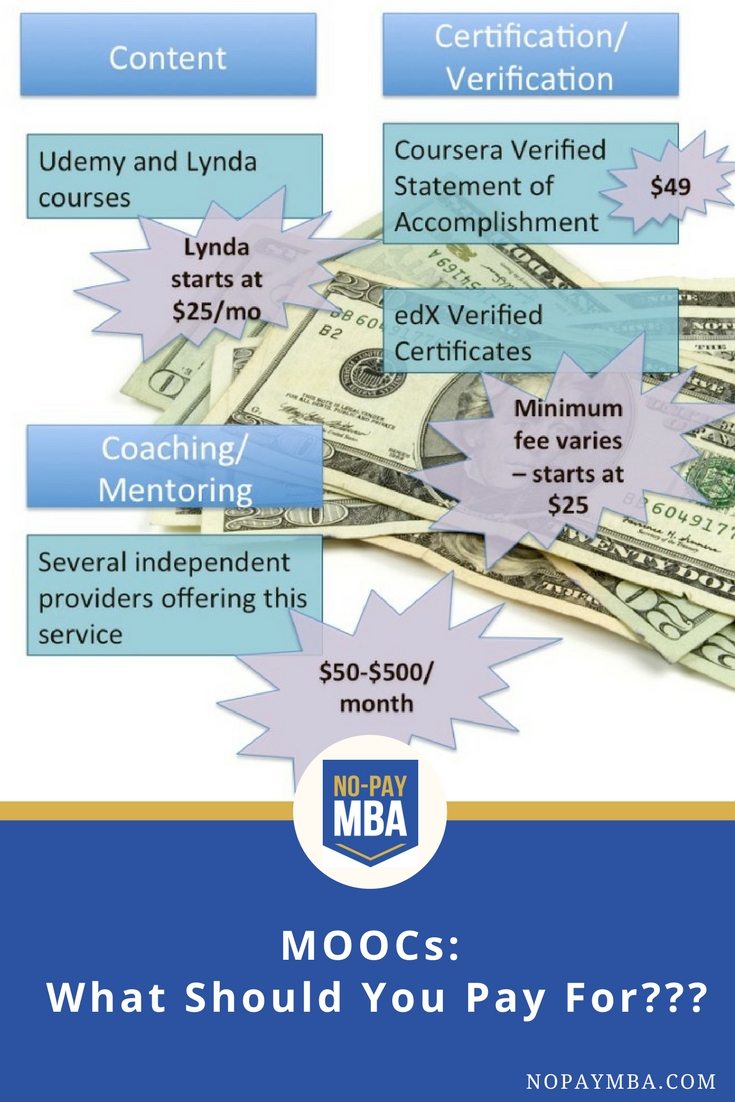
As the MOOC providers search for viable revenue models, the number of things you can pay for in the MOOC world has exploded. From subscription sites like Lynda, to micro-credentials like Udacity’s Nanodegrees and Coursera’s Specializations, the array of options is dizzying. None is as expensive as regular college credit, but fees for MOOCs now range from free with an option to pay $50 for a verified certificate (Coursera, edX), to upwards of $900 for a single course (NovoEd), to $200 per month for access to as many courses as you can handle (Udacity, Lynda).
In the early days of massive open online courses you couldn’t pay for a course or a certificate if you wanted to.
In my opinion, the proliferation of non-free options is a good thing; it is only by having sustainable business models that the MOOC platforms will be able to stay in existence and continue producing high-quality content.
But given that all of these products are new and unproven, as a MOOC student it can be confusing to sort through them.
What is your goal and how much can you afford?
Just over a year ago, an article about the No-Pay MBA went viral. The headline made reference to a figure of $1000, which was how much I planned to spend on my MOOC-based MBA equivalent. That original estimate of $1000 was actually what I planned to spend to build my website – including hosting, the price of the site itself, some help from people who know more about the internet than I, and other assorted fees associated with running a website. I had not at that time – and in fact I still haven’t – spent any money on courses themselves. To be precise, mine is not a $1000 education, but rather a free education with a $1000 website.
There are a lot more ways to spend $1000 on online learning now than there were a year ago, but the approach I would recommend hasn’t changed.
- First, get very clear about your goals.
- Second, determine how much money you can afford to spend to reach those goals.
- Finally, when deciding how to spend that money, look for those options that do some combination of the following:
- Give you access to specialized content
- Provide you the motivation to finish your courses
- Lend credibility to your studies
When I started this project, I didn’t need to pay for specialized content, since the content I needed was available for free. But I did need to find a way to bring credibility to my effort – and to stay motivated enough to see it through. Building a website was the best way to build credibility for online learning, and being accountable to my readers has been critical to maintaining the motivation I need to complete my courses.
Fortunately, you have many options when it comes to accessing specialized content, maintaining motivation, and building credibility. With those key principles in mind, here is my take on what you should pay for when it comes to online education.
Certificates and identity-verified certificates
What they are
Most MOOC platforms give certificates – free or paid – to indicate a student’s completion of a course. Coursera and edX also offer an identity-verified certificate to ensure that the student who holds the certificate is the person who did the work for the course.
How much they cost
Coursera and edX will give you a basic certificate for free. Future Learn and MiriadaX offer paid certificates (£29 and €40, respectively). Coursera’s identity-verified Statement of Accomplishment costs $49 per course. edX verified certificates are on a sliding scale, with prices typically starting at $25 or $50 per course.
Worth it?
If you need the extra motivation, yes. I’ve written a more detailed analysis of the value of identity-verified certificates, but when it comes to credibility, I don’t think these fancier certificates are worth the expense – unless paying for the certificate will give you the motivation you require to finish the course. Of course, you may want to support a non-profit like edX, or the course may be part of a longer series which requires identity-verification for the overall cert. Which brings me to the next option.
Micro-credentials
What they are
Series of courses packaged into sets. Udacity’s Nanodegrees are primarily for IT topics. Coursera has partnered with Wharton to offer a Business Foundations Specialization. edX offers a Specialization in Supply Chain Management.
How much they cost
Udacity charges $200 per month, so the more quickly you finish, the less you spend. Coursera charges $595 for its Business Foundations Specialization ($95 per identity-verified course certificate, plus $215 for a capstone project). edX charges $375 for the Supply Chain Management series.
Worth it?
A pretty good bet. Micro-credentials are still very new, but with employers now collaborating on their design, they are likely to look very good on a resume. Good enough to replace a degree? Not yet, but who knows what the future will bring.
Course content
What it is
Some sites require you to pay just to access their content. The most popular of these sites are Lynda, Udemy, and Udacity.
How much it costs
Varies significantly - $25 per month for a basic Lynda subscription, from $40 to $200 for most coursees on Udemy, $200 per month on Udacity.
Is it worth it?
Yes, if you can’t get the content for free somewhere else, and if you’ll use it consistently.
Mentorship/Coaching
What it is
Support from a tutor or coach as you work your way through the course content. Udacity offers limited coaching in its Nanodegrees. Sites like Thinkful and SlideRule specialize in coaching students through courses on coding and programming.
How much it costs
Part of the monthly fee on Udacity, SlideRule charges $400 per month, and Thinkful charges $500 per month. I offer more affordable packages, starting at $50 per month. You can learn more about No-Pay MBA coaching packages here.
Worth it?
Yes. Not many options exist yet for business students – this service is primarily geared towards IT courses – but having someone there to help you along is key to course completion, especially for difficult subjects.



